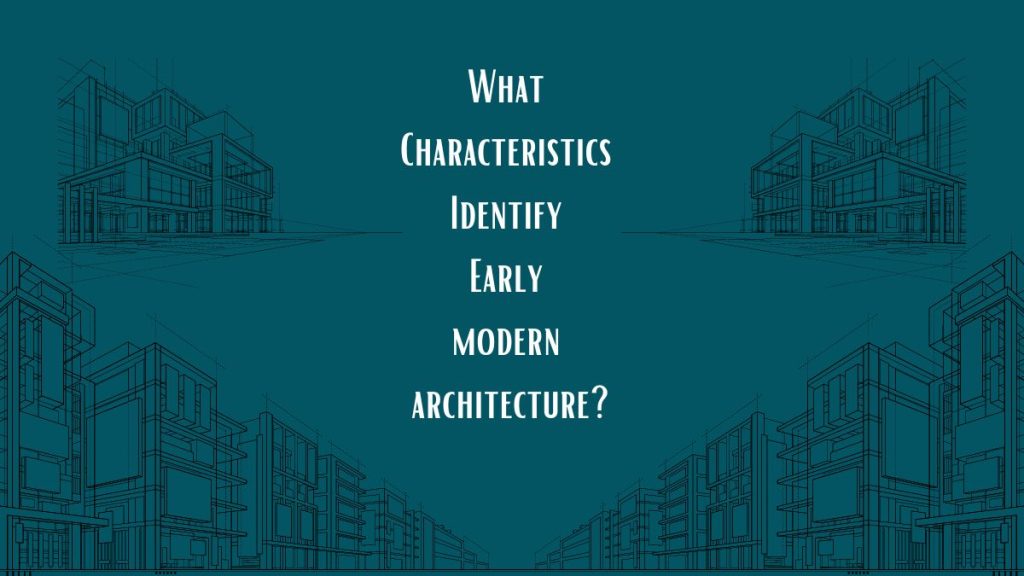Early Modern Architecture is characterized by simplicity, functional design, and the use of new materials like steel and glass. It emphasizes clean lines and open spaces. Here, we will discuss what characteristics identify early modern architecture and how it impacts architecture.
Early Modern Architecture emerged in the early 20th century, breaking away from traditional forms. Architects began to prioritize functionality over ornamentation. They used new materials such as steel, glass, and reinforced concrete. The designs focused on minimalism, clean lines, and open, adaptable spaces.
This era saw the rise of influential architects like Le Corbusier, Walter Gropius, and Frank Lloyd Wright. Their innovative ideas shaped the future of architectural design. Early Modern Architecture remains a significant influence in contemporary building practices. It set the stage for the sleek, efficient structures we see today.
Related Article: How Does Architecture Help Society: Shaping Our World
You may also read: Organic Architecture: Harmonizing Nature and Design

Related Article: Architectural Design Process: Unveiling Creativity
You may also read: Urban Design Principles: Transforming Cities for the Future
The Dawn Of Early Modern Architecture
The early modern architecture era marked a significant shift in design. This period introduced new ideas and materials. Architects began to explore and push boundaries. The focus shifted to functionality and simplicity.
Inception Of A New Architectural Era
The late 19th and early 20th centuries saw rapid changes. Industrialization brought new building technologies. Steel and reinforced concrete became the primary materials. These materials allowed for taller and stronger structures.
- Rejection of ornamentation
- Emphasis on clean lines
- Open floor plans
- Increased use of glass
Architects aimed to make spaces more functional. They believed buildings should serve their purpose well. This era focused on practicality over aesthetics.
Key Pioneers And Their Influence
Several architects stood out during this time. Their work shaped early modern architecture. They introduced innovative ideas and designs.
| Architect | Contribution |
|---|---|
| Le Corbusier | Promoted the use of open spaces |
| Frank Lloyd Wright | Introduced organic architecture |
| Walter Gropius | Founded the Bauhaus School |
Le Corbusier believed in the house as a machine for living. He focused on functional designs with minimal ornamentation. Frank Lloyd Wright introduced the concept of organic architecture. His designs aimed to harmonize with the environment. Walter Gropius founded the Bauhaus School, blending art and technology.
Architectural Features And Styles
Early Modern Architecture emerged in the late 19th and early 20th centuries. It marked a departure from ornate designs and embraced simplicity. This style focused on new construction techniques, materials, and a functional approach. Let’s explore its defining characteristics.
Minimalism And Functionality
Early Modern Architecture emphasizes minimalism and functionality. Buildings often feature clean lines and open spaces. There is a lack of decorative elements. The design is straightforward and practical.
- Simplified forms
- Open floor plans
- Large windows
These elements create a sense of openness and light.
Materials And Construction Techniques
Early Modern architects used innovative materials and construction techniques. Concrete, steel, and glass became popular. These materials allowed for new architectural possibilities.
| Material | Characteristics |
|---|---|
| Concrete | Durable and versatile |
| Steel | Strong and flexible |
| Glass | Transparent and elegant |
These materials supported the creation of new structures.
Reinforced concrete allowed for larger buildings. Steel frames provided strength and flexibility. Glass walls brought in natural light.
These features helped define Early Modern Architecture.
Related Article: The Timeless Appeal of Brick in Modern Architecture: A Complete Guide
Related Article: Alternative Careers for Architects: Exciting New Paths to Explore

Related Article: Architectural Design Concepts: Unleash Creativity
You may also read: Architectural Journalism: Exploring the Intersection of Design and Media
Iconic Early Modern Buildings
Early Modern architecture is known for its clean lines and innovative designs. These buildings often feature new materials, open spaces, and functional forms. Let’s explore some iconic examples that define this era.
Case Study: Villa Savoye
Villa Savoye is a prime example of Early Modern architecture. Designed by Le Corbusier, it embodies the principles of the International Style. Located in Poissy, France, it was completed in 1931.
- Open Floor Plan: The interiors are free of load-bearing walls.
- Pilotis: These are columns that lift the building above the ground.
- Flat Roof Terrace: It serves as a garden and outdoor living space.
- Horizontal Windows: They provide uniform lighting and a panoramic view.
- Free Facade Design: The walls are independent of the structural frame.
| Feature | Description |
|---|---|
| Open Floor Plan | Spaces flow into each other without walls. |
| Pilotis | Columns elevate the structure. |
| Flat Roof Terrace | Roof used as an outdoor area. |
| Horizontal Windows | Allow for even lighting and views. |
| Free Facade Design | Walls are not load-bearing. |
Case Study: Barcelona Pavilion
The Barcelona Pavilion was designed by Ludwig Mies van der Rohe. It was built for the 1929 International Exposition in Barcelona, Spain.
- Minimalist Design: Emphasizes simplicity and clarity.
- Open Space: Large, open rooms without clutter.
- Luxurious Materials: Marble, onyx, and travertine are used.
- Floating Roof: Supported by slender steel columns.
- Reflective Pools: Enhance the sense of space and light.
- Minimalist Design: Focuses on the essential elements.
- Open Space: Provides a sense of freedom.
- Luxurious Materials: Adds elegance to the structure.
- Floating Roof: Creates a light, airy feel.
- Reflective Pools: Adds visual depth.

Credit: en.wikipedia.org
You may also read: Best Architecture Books to Inspire Your Next Design Masterpiece
Urban Planning And Early Modernism
Urban planning played a significant role in early modern architecture. Cities transformed rapidly during this period. Architects and planners designed spaces to improve living conditions. Public spaces and residential designs saw notable changes.
City Landscapes And Public Spaces
Early modern architects focused on open spaces. They designed parks and plazas for public use. These spaces were meant for everyone. Parks provided a place for relaxation and recreation.
Plazas became gathering spots for the community. They often featured statues or fountains. Public buildings were also important. Libraries, museums, and schools were built in central locations.
These buildings had simple, clean lines. The designs were functional yet aesthetically pleasing. This approach made cities more livable.
Impact On Residential Designs
Residential areas saw significant changes. Early modern homes featured open floor plans. Large windows allowed more light inside. This made homes feel brighter and more spacious.
Materials like concrete and steel became popular. These materials were both durable and modern. Many homes also had flat roofs. This was a departure from traditional sloped roofs.
Minimalism was a key feature in home design. Furniture and decorations were kept simple. This created a sense of calm and order. Early modern homes were designed for efficient living.
Legacy And Evolution
Early Modern Architecture transformed the way buildings were designed. It brought innovative ideas and new materials. This movement’s legacy shapes today’s architecture. Its evolution continues to influence modern designs.
Influence On Contemporary Architecture
Early Modern Architecture introduced simplicity and functionality. These principles remain crucial in contemporary designs. Modern architects often use clean lines and open spaces.
Key Features that influence contemporary architecture include:
- Minimalist design
- Use of new materials like steel and glass
- Open floor plans
- Integration with nature
These elements help create sustainable and aesthetically pleasing structures. The legacy of Early Modern Architecture lives on in today’s buildings.
Preservation And Relevance Today
Many early modern buildings are preserved as historic landmarks. These structures showcase the innovation of the era. Preservation efforts ensure these buildings stay relevant.
The relevance of Early Modern Architecture can be seen in:
- Educational programs that teach its principles
- Restoration projects that maintain historic buildings
- Incorporation of its elements in new designs
Preserving these structures allows future generations to appreciate their significance. Early Modern Architecture continues to inspire and influence modern architectural practices.
Related Article: Brutalist Architecture Characteristics: Unveiling Bold Design Elements

Credit: study.com
Related Article: Urban Design Ideas: Transform Your Cityscape with Innovation
You may also read: Architectural Solutions: Transforming Spaces with Innovative Design
What Characteristics Identify Early Modern Architecture>>
Conclusion
Early Modern Architecture is defined by simplicity, functional design, and innovative use of materials. These characteristics distinguish it from previous styles. Its influence continues to shape contemporary architecture. Recognizing these features helps appreciate the evolution of architectural design. Explore Early Modern Architecture to understand its lasting impact on the built environment.
Related Article: How to Choose the Right Architect: Top Expert Tips
You may also read: Modern Architecture Styles: Discover Cutting-Edge Designs

Pingback: Architectural Design Process: Unveiling Creativity - SpaceArc
Pingback: Modern Architecture Styles: Discover Cutting-Edge Designs - SpaceArc
Pingback: Architectural Solutions: Transforming Spaces with Innovative Design - SpaceArc
Pingback: Best Architecture Books to Inspire Your Next Design Masterpiece - SpaceArc